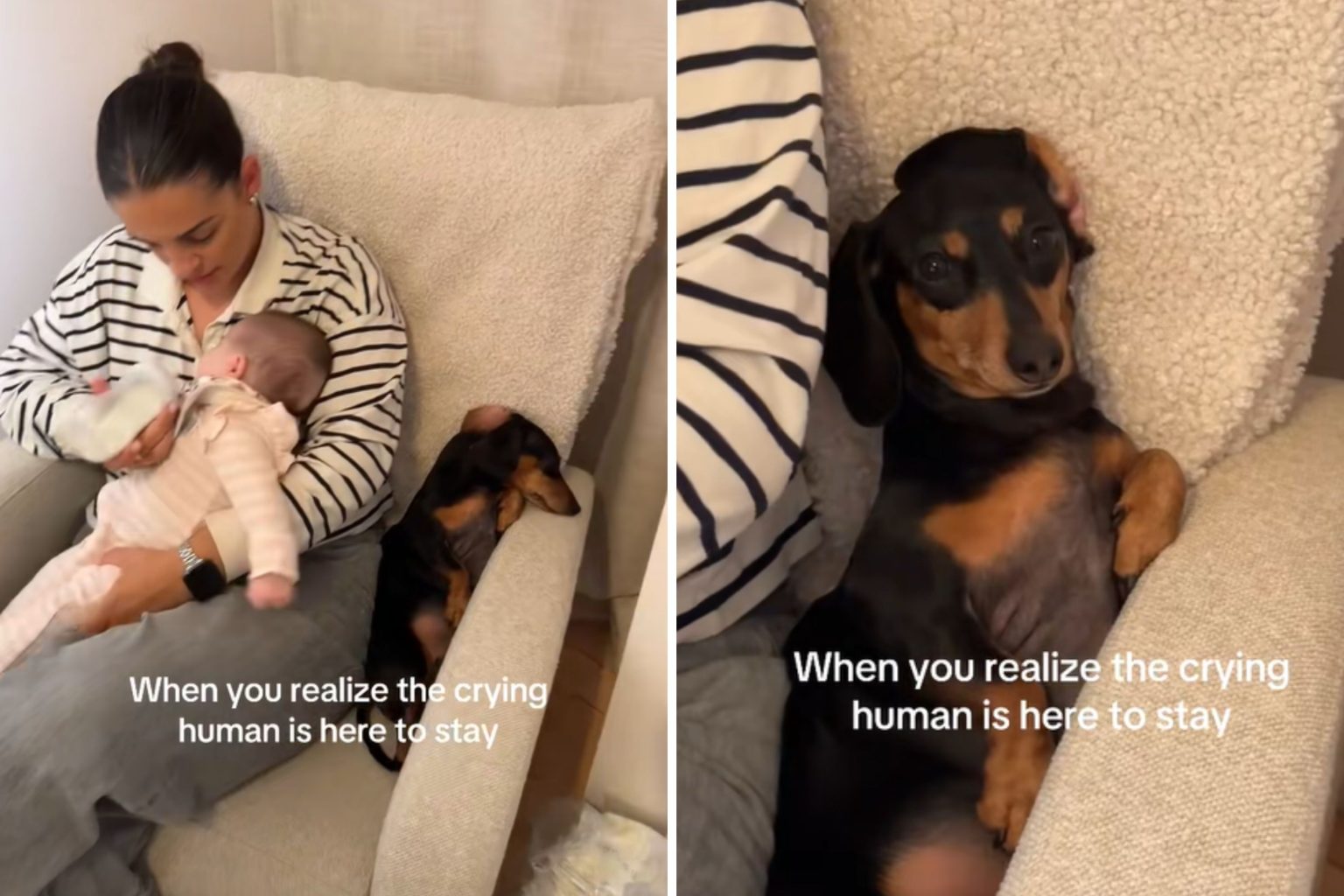When the Family Dog Meets the New Baby: A Tale of Adjustment
In a heartwarming yet humorous viral moment, a dachshund named Roo has captured the internet’s attention with her less-than-enthusiastic reaction to her family’s newest addition. The August 26 TikTok video, which has amassed over 1.4 million views and nearly 300,000 likes, shows Roo sitting reluctantly beside her owner and the crying newborn baby. In what can only be described as classic canine disapproval, Roo attempts to ignore the baby’s cries by resting her snout on the chair’s edge and closing her eyes, only to open them moments later with a side-eye glance that perfectly communicates her displeasure. As her owner later explained to Newsweek, “Anytime she cries, Roo typically crawls under a blanket. She isn’t used to being a sibling!” The video showcases the genuine adjustment period many family pets experience when their once-peaceful home welcomes a tiny, loud human who demands constant attention.
The transition from being the “baby” of the family to sharing the spotlight is rarely smooth for our four-legged friends. Roo’s reaction represents what many pet owners witness when introducing a newborn to their home – a mixture of confusion, jealousy, and mild annoyance as routines are disrupted and attention is divided. According to VCA Animal Hospitals, dogs often need time to adapt to such significant household changes, with adjustment periods varying from just a few days to several weeks depending on the dog’s personality and the family’s approach to the transition. Fortunately for Roo’s family, while her facial expressions speak volumes about her feelings on the matter, she hasn’t shown any signs of aggression toward the baby – just a clear preference for the quieter days of the past when she didn’t have to share her humans with a crying newcomer.
Dachshunds like Roo have distinctive personalities that make their reactions to family changes particularly entertaining. Originally bred as independent hunters with a mission to track badgers, these small dogs carry a surprising amount of determination and stubbornness in their elongated bodies. The American Kennel Club rates dachshunds a moderate three out of five for compatibility with children, noting their brave yet occasionally headstrong nature. While they might be small, dachshunds are sturdy enough to handle the sometimes clumsy interactions with children, making them resilient family pets despite their occasional preference for peace and quiet. Their expressive faces – as perfectly demonstrated by Roo’s side-eye in the viral video – make their feelings abundantly clear, creating moments of connection and humor that families treasure.
The internet’s reaction to Roo’s video highlights how relatable pet adjustment struggles are for many families. Comments flooded in describing her expression as the “look of betrayal,” with one viewer sympathetically writing, “She said: ‘Please tell me this is just a bad dream.'” Another commenter joked that the puppy was giving a “‘Return to Sender’ look” to her owners about the new baby. The video tapped into a universal experience that many pet owners face: helping their first “baby” adjust to no longer being the center of attention. Despite Roo’s initial reaction, many commenters offered encouraging words about the future relationship between the dog and baby, with one optimistically noting, “They’re going to be partners in crimes, just give them a couple of months.”
Behind the humor of Roo’s reaction lies an important reality for families expanding to include both children and pets. The transition requires patience and understanding from pet owners, who suddenly find themselves balancing the needs of their animal companions with the demands of a newborn. For dogs like Roo, the sudden change in routine, the unfamiliar sounds of a crying baby, and the inevitable shift in attention can be genuinely disorienting. Many veterinarians and animal behaviorists recommend gradually introducing pets to baby-related items before the newborn arrives, maintaining some semblance of the pet’s previous routine, and ensuring the animal still receives dedicated attention and affection. These strategies help ease the transition for four-legged family members who didn’t exactly “sign up” for their new sibling role.
While Roo’s viral moment captures a single instant of adjustment, it represents the beginning of what will likely become a beautiful relationship between child and pet. Many families report that after the initial adjustment period, dogs often become protective, loving companions to the children in their households – relationships that benefit both the child and the animal. Children raised with pets often develop greater empathy, responsibility, and emotional intelligence, while dogs frequently thrive with the additional attention and activity that growing children provide. Though Roo might currently prefer to hide under blankets when the baby cries, her expressive reaction has not only entertained millions but also reminded us of the complex emotional lives our pets lead as they navigate family changes alongside us. With time, patience, and continued love from her owners, Roo may soon find that having a little human sibling brings unexpected joys that make the adjustment period worthwhile.















